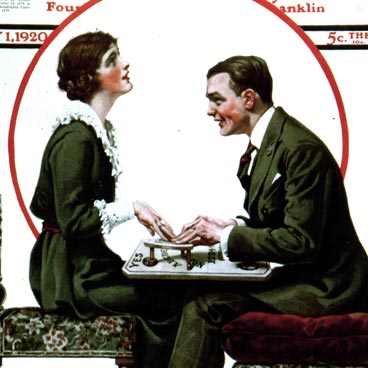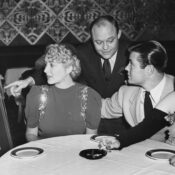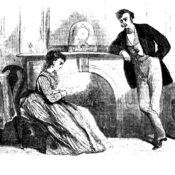A reader recently e-mailed the Post archives, asking for a story by Pearl Curran that appeared in November 1919. He had learned about Pearl in Smithsonian magazine and became so fascinated, he said, it “made me want to read the Curran’s work.” Peral Curran enjoyed brief popularity as an author in the 1910s. What made her so big was the fact she was a medium.
Spiritualism had become hugely popular the late 19th century as American began holding seances to converse with the dead. In the 1910s, though, the Ouija Board became popular. It didn’t require a number of people around a table. In fact, it could be used by just one or two people.
If you don’t know, an Ouija board displays letters of the alphabets, numbers, and the words “yes” and “no”. Participants rest their fingers on a heart-shaped pointer and ask questions. When a “spirit” so desires, it moves the pointer to letters spelling out answers.
After Pearl Curran lost her father around 1912, her friends persuaded her to try contacting him with a Ouija board. She didn’t reach her father, but something just as incredible happened. One night the pointer spelled out a spirit’s name, “Patience Worth”, who wanted to communicate with Pearl. And communicate she did. “Patience Worth” had lived in the 1600’s and had much to tell, and dictate to her “vessel” Pearl Curran.
Over time, “Patience Worth” dictated poems, plays and entire novels. The volume of work and time authenticity of the dictations convinced many skeptics, and Pearl became a celebrity, with crowds coming to hear her relay the works of “Patience Worth”. Prominent writers, psychologists, journalists, and skeptics tried to prove this was all nonsense, but none succeeded. In fact, some of the best minds of the time were convinced that “Patience Worth” was indeed writing though Pearl.
However, in 1919, a story by Pearl Curran was accepted by The Saturday Evening Post. Entitled “Rosa Alvaro, Entrante” (“Enter, Rose Alvaro”) it was Pearl’s own work, written without any help from her spirit, Patience Worth.
The plot would have been interesting to Post readers who knew Pearl Curran’s history. A bored clerk named Mayme, who sells hosiery at a department store, is fed up. “There’s nothing but this forever,” Mayme complains to a co-worker friend, Gwen. “I’m sick of seein’stockin’s and thinkin’ feet…I know every day by heart and they ain’t nothin’ more for me to learn.” Bored quite literally to tears by a dull job and even duller room at “Mrs. Winthrop’s home boarding and rooming establishment,” Mayme visits a clairvoyant. A spirit named Laughing Water speaks through the clairvoyant and insists that another spirit named Rosa Alvaro (“a beautiful Spanish lady”) has watched over Mayme since childhood. Rosa Alavro’s spirit wants the bored sales girl to follow her as a clairvoyant. “You will be big lady, Laughing Water say.”
Enter, Rosa Alvaro. Mayme begins to slip into the Spanish accent and free lifestyle of the spirit, to the nervousness of her friend — and to the fascination of Mr. Peacock at work. “She’s everything I want to be,” Mayme tells Gwen. “I can’t be nothin’. What’s the use of me? Nobody ever sees me. I tell you, you shan’t stop her!”
Concerned friend Gwen goes to a psychologist. “There’s a man in it sure. No woman goes nuts any other way. Now there’s the dope. What’s the cure? If you got one trot it out.” These working gals can be rather blunt of speech.
Is Mayme a clairvoyant or a multiple personality? Oddly, these were the very questions asked of the author, Pearl Curran. To which there was never a definitive answer.
There was an answer for Mayme in Pearl’s story, though. Mayme confides to her friend that it was all a game. “I was sick of myself. I wanted to feel, feel like a woman that somebody cared about.”
Was Pearl Curran revealing herself in this story? Those who believed that Patience Worth wrote through Pearl Curran, chose to ignore the story in the Post and continue believing that the author was the real thing. The literary output from her spirit, they explained, was just too good, and too successful, for an ordinary St. Louis housewife. And Pearl Curran herself? In spite of the story published by the Post, her literary career never took off.
Become a Saturday Evening Post member and enjoy unlimited access. Subscribe now



